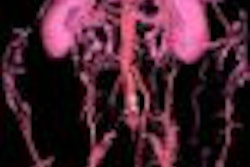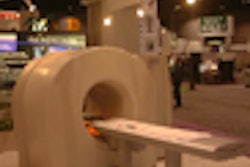In hope of expanding the period during which a stroke patient can undergo treatment successfully, German researchers used CT perfusion imaging (CTP) for assessment of acute stroke of the middle cerebral artery.
A group of neurologists and radiologists from Friedrich Schiller University in Jena imaged 22 patients with CT and CTP within the first six hours after admission to the stroke unit.
"The detection of malperfused brain tissue in the acute stage would help to limit thrombolysis to patients who are likely to benefit and might set the rationale for extending the therapeutic window to later time points," the group wrote. (Archives of Neurology, August 2000, Vol.57, pp.1161-1166)
For the dynamic CT perfusion studies, a series of 25 or 40 scans were acquired in a single slice with a 10-mm slice thickness during the injection of 60 mL of a nonionic contrast agent (Ultravist 300, Schering, Berlin, Germany). A standardized slice that covered the basal ganglia, the thalamus, and parts of the anterior, middle, and posterior arterial territories was assessed.
The imaging protocol for the follow-up CT consisted of axial images acquired in an orbitomeatal orientation using a slip-ring CT scanner (Somatom Plus S, Siemens Medical Systems, Erlangen, Germany) and 5-mm slice thickness.
"We hypothesized that (1) the single-slice approach is sensitive for the detection of major, clinically relevant perfusion deficits; (2) the area of the initial perfusion deficit in CTP correlates with the severity of stroke symptoms, clinical recovery, and final infarct size; and (3) the reperfusion area and areas of saved tissue as detected by follow-up CT and CTP are useful indicators of therapeutic efficacy," they said.
Of the 22 patients, 18 had perfusion deficit on CTP while four had normal results. In patients with proven territorial infarction on follow-up CT, the overall sensitivity of CTP for detection of perfusion deficits was 95% and the specificity was 100%.
The mechanism of infarction in the majority of patients (44%) was large-artery atherosclerosis. Based on CTP results that met criteria set by the National Institute of Neurological Disorders and Stroke, six patients received recombinant tissue-type plasminogen activator immediately after follow-up CT and within three hours of symptom onset.
In addition, eight patients were included three to six hours after stroke onset and were given intravenous heparin in an effort to increase the partial thromboplastin time. Four patients were enrolled in acute stroke trials as long as six hours after stroke onset.
The group reported three patterns of stroke evolution: areas of hypoattenuation on follow-up CTP described as "partial nutritional reperfusion," areas of hypoattenuation on follow-up CT equal to the area of the initial perfusion deficit, and reperfusion on a second CTP scan described as "nonnutritional reperfusion." Finally, there were areas of hypoattenuation on the follow-up CT scan that were equal to the area of the initial perfusion deficits without reperfusion.
"Based on our series we find that patients with acute stroke might benefit from … CTP-derived information on a mismatch between perfusion deficit and CT hypodensity," the researchers said. "CTP might be used to expand the rigid therapeutic window of three hours."
The group also suggested that CTP had some advantages over other imaging modalities. Compared with CT angiography, they stated that CTP delivered more functional information about tissue perfusion. While PET and MRI are adept at defining perfusion deficits within the acute time window, the techniques are "limited to specialized stroke centers," they said.
In comparison, "dynamic CT perfusion imaging … is easily accessible to a broad community [and] is an easily performed add-on examination," they concluded. "CTP is sensitive for the detection of territorial perfusion deficits in the middle cerebral artery territory and is easily applicable with minimal additional scan time."
By Shalmali Pal
AuntMinnie.com staff writer
August 28, 2000
Let AuntMinnie.com know what you think about this story.
Copyright © 2000 AuntMinnie.com



















